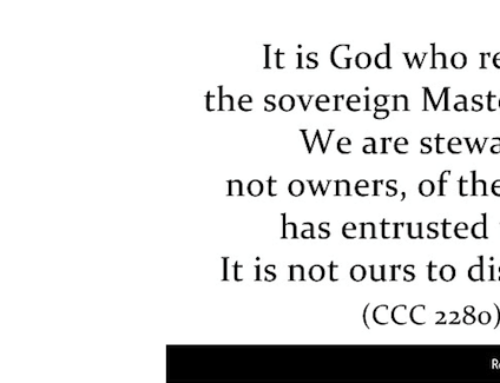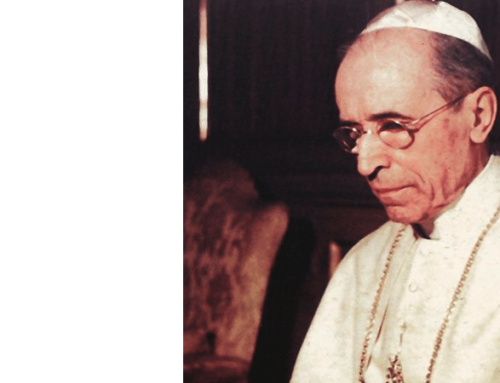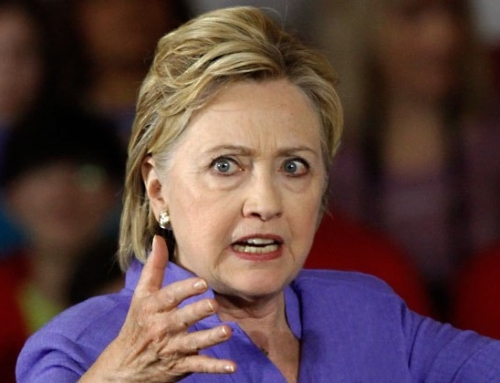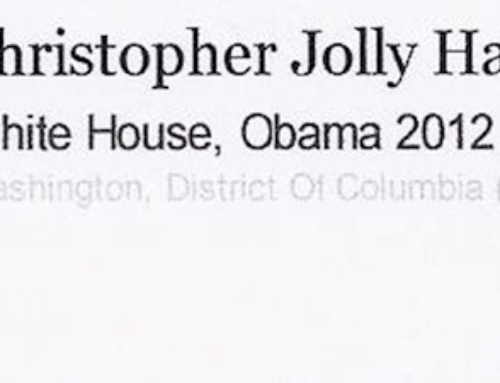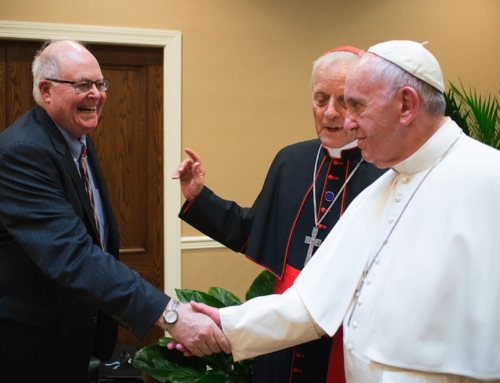by William A. Donohue
(Catalyst 10/1996)
Perhaps the most invidious form of anti-Catholicism is that which emanates from elite circles. When men and women of power and influence engage in Catholic bashing, the effects can be devastating, which is why the Catholic League responds so quickly and decisively. But there is also a brand of anti-Catholicism that comes from less urbane quarters, from places that target the undereducated. And no one is better at doing this than Chick Publications.
Founded by Jack Chick, his company publishes books, magazines, small tracts and comic books, and now releases videos, all of which are designed to convince Protestants that Roman Catholicism is a false religion; Chick also distributes anti-Catholic works published by other sources. Perhaps best known for its release of 3×5 cartoon-like tracts, Chick has operations all over the world. Headquartered in Chino, California, Chick has outlets in Scotland, Germany, Canada, New Zealand and Australia.
Chick’s booklets are available in Afrikaan, Albanian, Bulgarian, Burmese, Cambodian, Chichewa, Chinese, Creole, Croatian, Czech, Danish, Dutch, English, Estonian, Finnish, French, German, Greek, Haitian, Hindi, Hungarian, Italian, Japanese, Korean, Lithuanian, New Guinea, Norwegian, Pidgin, Polish, Portuguese, Romanian, Russian, Serbian, Slovak, Spanish, Swahili, Swedish, Tagalog, Thai, Turkish, Ukrainian, Vietnamese and Zulu. Priced to sell at just 13 cents each, Chick has done a masterful job marketing its hatred. Titles include “Are Roman Catholics Christians?”; “Why is Mary Crying?”; and “The Death Cookie,” which by that is meant the Host.
The Alberto series of comic books are also quite popular. Aimed primarily at teenagers, this series is based on the work of Alberto Rivera, a man who claims to be an ex-Jesuit from the Diocese of Madrid. Past research by the Catholic League, however, shows no record of Rivera ever being a priest. Vintage Chick in content, the comic books are strewn with vile anti-Catholicism.
Catholicism’s Errors
Chick specializes in attempting to debunk Catholic teachings, thereby preparing the confused for eventual conversion to Protestantism. For example, in his book Answers to My Catholic Friends, Thomas F. Heinze writes that “There is no real salvation in the Roman Catholic Church.” From William C. Standridge in Born-Again Catholics and the Mass, we learn that Catholics cannot be “born again.” Ralph Edward Woodrow, in his book Babylon Mystery Religion, goes further by arguing that Mary is the “goddess of paganism” and that “a mixture of paganism and Christianity produced the Roman Catholic Church.”
Understanding Roman Catholicism, by Rick Jones, purports to explain “37 Roman Catholic Doctrines.” The reader gets an idea of the author’s explanations by reading the following conclusion: “Catholicism brings people into bondage.” For those who prefer a video presentation of so-called Catholic mythology, there is Catholicism: Crisis of Faith, by Lumen Productions. The 54 minute video divides Catholic “errors” into four sections: the Mass; Statues; Mary; and Catholic salvation. As expected, the video attacks transubstantiation, misrepresents Catholic teachings on statues and Our Blessed Mother, and contends that faith alone is necessary for salvation.
Some of the assaults on Catholicism chose quite specific topics, such as Charles Chiniquy’s The Priest, the Women and the Confessional. This book, written by a nineteenth century former priest, has had quite a run, covering the span of a century and a half. Confession, we are told, is the invention of Satan. In practice, “The confessor is the worm which is biting, polluting, and destroying the very roots of civil and religious society, by contaminating, debasing, and enslaving women.”
Speaking of wives, Chiniquy writes that “As she becomes an adulteress the day that she gives her body to another man, is she any the less an adulteress the day that she gives her confidence and trusts her soul to a stranger?” Chiniquy writes like a contemporary reporter for Enquirer orThe Star when he says that the “poor confessor” is “surrounded by attractive women and tempting girls, speaking to him from morning to night on things which a man cannot hear without falling.” This is because the woman confesses “her constant temptations, her bad thoughts, [and] her most intimate secret desires and sins.”
In a recent Chick listing, Far From Rome: Near to God, we have the alleged testimony of 50 converted Catholic priests. All have found the “errors in the Church” and have since seen the light. Most of the laments are quite dry, but there is one that deserves a comment.
Leo Lehmann was born in Dublin in 1895, and right from the beginning was saddled with despair. “I have no joyous memories of my boyhood years.” None. His attributes his misery to the “fear” he experienced being raised Catholic. The fear he felt had dramatic consequences: “It was principally the fear connected with everything in the Roman Catholic religion that helped me with my decision to become a priest.”
The day Lehmann was ordained, he noticed late at night that one of his companions “became affected in his mind, the strain of mechanical routine, innumerable petty restrictions and formulas,” a condition Lehmann describes as “a species of religious madness called `scrupulosity.’”
In another incident, Lehmann says he remembers the case of a fourteen year-old girl who suffered from insanity. He blames Catholicism for her insanity, stating that when he met her, she constantly recited the “Hail Mary.” Obviously intending to persuade the reader, Lehmann maintains that “Her mind was deranged by the idea that she was obliged to say this prayer a hundred times each day, and in order to make sure of having them said on time, she was over a thousand ahead. Some priest, doubtless, had imposed the saying of these `Hail Mary’s’ as a penance in confession.” Doubtless. Anyway, this was enough to have the fear-ridden Lehmann call it quits.
The “Secret Army” of the Jesuits
It will surprise no one to learn that Jack Chick thinks he’s a regular guy. In his infamous book, Smokescreens, Chick says “There has been a multi-million dollar campaign made through the media to convince people that I am a bigoted, anti-Catholic hate literature publisher.” But this is nonsense, as there has been no well-funded campaign of any sort. And to the extent that even a dollar has been spent trying to convince people that Chick is a bigot, it’s a waste of money: just reading his hate-filled books is evidence enough.
Just two pages after Chick makes his remarkable protest that he is not an anti-Catholic bigot, he writes of the Eucharist that “I call it the little Jesus cookie.” Anticipating criticism, Chick adds, “I know Catholics are going to be offended by this, but I can’t help it. The Protestants have to realize where they stand on this thing.”
It’s a sure bet that most Catholics never knew that “The Jesuits had secretly prepared World War II, and Hitler’s war machine was built and financed by the Vatican to conquer the world for Roman Catholicism.” And how many knew that “Hitler, Mussolini, and Franco were to be the defenders of the faith”? It gets better: “They were set up to win and conquer the world, and set up a millennium for the pope. Behind the scenes, the Jesuits controlled the Gestapo.” Somehow every historian who has written on World War II seems to have missed these “facts” altogether, but not the world-renowned scholar, Jack Chick.
So pro-Nazi was the Catholic Church that Chick regrets that Pope Pius XII wasn’t killed. “Pope Pius XII should have stood before the judges in Nuremburg. His war crimes were worthy of death.” But if the Catholic Church was fascist, and the fascists fought the communists in World War II, then Mr. Chick needs to explain why he charges the Jesuits with not only running the Gestapo, but with founding the Communist Party as well. He also wants us to believe that the Jesuits aided the John Birch Society, thus adding confusion to confusion. But to Jack Chick, at least, it all makes sense.
Jack really doesn’t like the Jesuits. As he sees it, the Society of Jesus managed to come to America just as the second wave of Pilgrims was beginning. Ever sneaky, the Jesuits “used different names with I.D.’s. They were followed years later when the Vatican sent multitudes of Catholic families from England, Ireland and France posing as Protestants, into the colonies. These were plants.”
But that was only the beginning. “The next move by the Jesuits,” Chick informs, “was to destroy or control all the Christian schools across America.” They did this, of course, by “working undercover,” infiltrating school boards and the like. This venture would then be followed by taking control of the legislature and judiciary “in order to manipulate the Constitution in their favor until it could be changed.” Next was a plot “to capture the political parties.” After that, “Then the military and the newspapers.” And so on. “It is obvious,” Chick states, “that the whore of Revelation is the Roman Catholic Institution, and God hates it!”
Michael de Semlyen, author of All Roads Lead to Rome? The Ecumenical Movement, is, like Jack Chick, sensitive to charges of bigotry. He says his book
“will be viewed by some as bigoted,” never explaining why anyone who has read his volume might think otherwise. But never mind, de Semlyen feels the same way about the Jesuits as Chick does, blaming them for both Hitler and Marxism. The Church, of course, is the “great whore of Revelation 17.”
Though similar to Chick, de Semlyen has a creative side to him as well. Readers learn, for example, that the “Roman Catholic hierarchy” played a role in the assassination of President Lincoln. Also newsworthy is the charge that the Vatican “has the most efficient and widespread spy network in the whole world” (de Semlyen is kind enough to attribute this finding to yet another careful student of Catholicism, Nino Lo Bello, in his book, The Vatican Papers).
Treating readers to another revelation, de Semlyen tells us that “There is much in Roman Catholic tradition to contribute to New Age thinking”; he fingers Mother Teresa as a primary force for New Ageism. Even more ground-breaking is the news that Vatican opposition to abortion, birth control and homosexuality “has little to do with the sanctity of human life and Biblical ordinance,” rather it stems from a need to add to the “Catholic army” and the financial resources of the Church.
The classic Jesuit-hating book was written by Edmond Paris. The Secret History of the Jesuits claims that the Jesuits constitute “a truly secret army” all over the world. According to Paris, the Jesuits have “kept alive” the Catholic Church’s “mad aspiration to govern the world.” “The public is practically unaware,” writes Paris, “of the overwhelming responsibility carried by the Vatican and its Jesuits in the start of the two world wars.” Indeed, “Catholics were the masters of Nazi Germany.”
Paris even blames the death camps on the Catholic Church: “The right the Church arrogates herself to exterminate slowly or speedily those who are in the way was `put into practice’ at Auschwitz, Dachau, Belsen, Buchenwald and other death camps.” As always, no documentation is ever presented to substantiate any of these outrageous claims. In conclusion, Paris says that the Jesuits are responsible for spreading “a kind of sclerosis, if not necrosis,” through the Church.
Catholic Cabals
Chick Publications loves to publish books that promote devil’s theories, but when it comes to conspiracy-minded plots that implicate the Vatican, few can top Avro Manhattan. In his best-selling work, The Vatican Billions, Manhattan sets the tone right from the start: “Christ was born, lived and died in poverty. His `church’ is a multi-, multi-billion concern.” In fact, the Catholic Church is “the wealthiest institution on earth.” But how did it get so rich? My favorite story is the one about the end of the first millennium.
It seems that as the year 1000 grew near, the people of Europe became nervous. Recalling tales about the end of the world, and remembering the Biblical injunction that it is easier for a camel to pass through the eye of a needle than for a rich man to enter the Kingdom of Heaven, Catholics began unloading their loot. The depository, of course, was the Church.
“When,” writes Manhattan, “following the long night of terror of the last day of December 999, the first dawn of the year 1000 lit the Eastern sky without anything happening,” many Catholics breathed a sigh of relief. “Those who had given away their property made for the ecclesiastical centers which had accepted their `offerings,’ only to be told that their money, houses, lands, were no longer theirs. It had been the most spectacular give-away in history.”
The result was predictable. “Since the Church returned nothing,” opines Manhattan, “she embarked upon the second millennium with more wealth than ever, the result being that the monasteries, abbeys and bishoprics, with their inmates and incumbents, became richer, fatter and more corrupt than before.”
Kind of reminds me of the Billie Holiday refrain, “Nice Work If You Can Get It.”
According to Manhattan, at the end of the Middle Ages, the Vatican resorted to some rather bizarre means to extract money from the peasants. Various bishops, Manhattan contends, were busy excommunicating insects, the result of which was an outpouring of revenue from grateful peasants. To be specific, leeches were excommunicated in 1451, caterpillars in 1480 (and again in 1587), snails got the boot in 1481 (they were dumped again in 1487) and grasshoppers were shown the door in 1516. He says not a word about the praying mantis, but perhaps this was an oversight. Either that or the bishops thought they were too holy to excommunicate.
In the nineteenth century, Manhattan tells us that the dogma of infallibility was struck “to lay the foundations of a novel structure directed at amassing the riches of the world with more efficiency than ever before.” In the twentieth century, the Church “secretly welcomed the Bolshevik Revolution,” but then had second thoughts and turned against “Red Russia.” Manhattan does not leave us in lurch, explaining this anomaly by stating that “Such double policies, conducted simultaneously at all levels during a period of years, were the result of the two most basic urges which have always bedeviled her [the Church’s] conduct throughout her long experience: insatiable greed for ecclesiastical aggrandizement and an equally insatiable appetite for any prospect of potential earthly wealth.”
Avro Manhattan’s The Vatican Moscow Washington Alliance follows the same logic. When fascism emerged in Europe, Pope Pius XI “welcomed” it as a bulwark against communism, calling Mussolini “the man sent by Divine Providence.” Not only does Manhattan fail to cite his sources for this charge, he cites not one source in his entire book. Be that as it may, we learn that Pius XI eventually turned against the fascists. That was a mistake: one of Mussolini’s physicians gave the pope a lethal injection for doing so. Pius XII was spared such a fate because he “helped Hitler into power.”
Manhattan credits Pope John XXIII with beginning the Vatican-Moscow alliance, but awards Paul VI the title of “the father” of this alliance. Essentially, Manhattan says that the Catholic Church was anti-Marxist from World War I to the death of Pius XII in 1958, and then turned left with the formation of the Vatican-Moscow alliance.
John Paul I, we learn, was “liquidated” because he was not anti-Russian; like Pius XI, he was drugged, only this time it was the United States government that did the job. The attempted assassination of John Paul II is credited to the Soviets, this a result of the Pontiff’s creation of the Vatican-Washington alliance. If there is a moral here, it is that popes live longer when they don’t get involved in alliances.
Manhattan is not optimistic. The “Curia-CIA Coalition,” started by John Paul II, has already succeeded in doing what it set out to do: “America has willingly surrendered her political seniority as a superpower to that of the Vatican.” He The Vatican, Manhattan declares, felt that “the whole of North America should by historical right, be Catholic.” This is not a fantasy, he instructs, but the result of “well-calculated plans.” The ultimate goal is to establish “the Catholic Church as a global religion.”
How could all this come to pass? Manhattan is angry with Protestants for allowing the “Catholicization of America,” by which he means the mass migration of Catholics into the U.S.; this is “destroying the traditional Protestant motivated America of the past.” Guess it’s fair to say that Latinos are not high on Manhattan’s list.
The “enfeeblement of the major Protestant bodies,” we are told, began with “ecumenism.” This is not simply Manhattan’s view, it’s the position of William Standbridge in What’s Happening in the Roman Church. Standridge pulls no punches, holding that “the present ecumenical campaign of the Roman church differs little from its purpose during the tortures and massacres of the inquisition: that is, to take control over all who call themselves Christians.” In other words, ecumenical dialogue is a manipulative scheme designed to crush unsuspecting Protestants.
Dave Hunt is similarly distressed by ecumenism. In his book, A Woman Rides the Beast, Hunt expresses his outrage over the 1994 joint declaration, “Evangelicals and Catholics Together.” For Hunt, this attempt at reaching a consensus on non-doctrinal matters, “overturned the Reformation and will unquestionably have far-reaching repercussions throughout the Christian world for years to come.” As he sees it, the Evangelical-Catholic accord means that Catholics will be considered Christians. Nothing could be worse: “The millions who were martyred…for rejecting Catholicism as a false gospel have all died in vain.”
In a section entitled “The Vatican and the New World Order,” Hunt says that “Uncompromising Christians will be put to death for standing in the way of unity and peace.” Our Blessed Mother, he argues, is to blame. “From current trends,” Hunt writes, “it seems inevitable that a woman [his emphasis] must ride the beast. And of all the women in history, none rivals Roman Catholicism’s omnipotent, omniscient, and omnipresent `Mary.’”
Much of the same charges hurled by other Catholic bashers are found in Hunt’s books. “The Roman Catholic Church is by far the wealthiest institution on earth.” When the Church asks the faithful for donations, “such pleas are unconscionable ploys.” For those dumb enough to think that Rio de Janeiro, with its seven hills, is the home of “spiritual fornication,” think again. “Against only one other city in history could a charge of fornication be leveled. That city is Rome, and more specificallyVatican City.”
Hunt goes further with this charge by saying that “The gross immorality of the Roman Catholic clergy is not confined to the past but continues on a grand scale to this day.” To make sure we get his point, Hunt contends that “popes, cardinals, bishops and priests without number have been habitual fornicators, adulterers, homosexuals, and mass-murderers–ruthless and depraved villains who pursued their degenerate lifestyles immune from discipline.” Nothing nuanced about that!
In his book, A Cup of Trembling: Jerusalem and Bible Prophecy, Hunt offers the standard line about Hitler and Himmler being good Catholics, and blames the Catholic Church for promoting Nazism. What drove the Church to do this? “The fanaticism that aroused Catholics to murder was often associated with the Eucharist and the wafer (Host).” Not to be outdone, Hunt brands recent statements by the Vatican condemning anti-Semitism as “hypocritical,” saying they are nothing more than “deceptive declarations.”
What Makes Chick Tick?
No serious student of religion or history would ever believe the absurd charges that Chick Publications specializes in, but that should hardly give us pause. There are millions of people all over the world who want to believe the worst about the Catholic Church, and unsophisticated though they may be, these men, women and children will never dislodge themselves of their hatred for Catholicism as long as they are given a steady supply of Chick fodder. To be sure, the Church will survive this assault, but that doesn’t relieve the objections that fair-minded people of every religion should have about Chick.
What makes Chick tick? In one four-letter word, it’s called ENVY. Chick writers attribute fantastic powers to the Catholic Church precisely because they see in the Church a strength and resourcefulness that is absent in Protestantism. In the West, in particular, Chick authors believe that Protestantism should have eclipsed Catholicism long ago. But it hasn’t, for reasons that reasonable people can debate. What can’t be debated is that those driven by envy (with a little madness thrown in) will never cease their offensive against the Church. The one true Church, that is.


